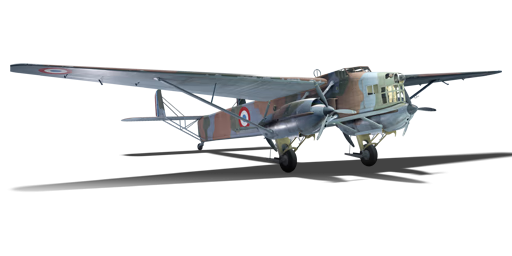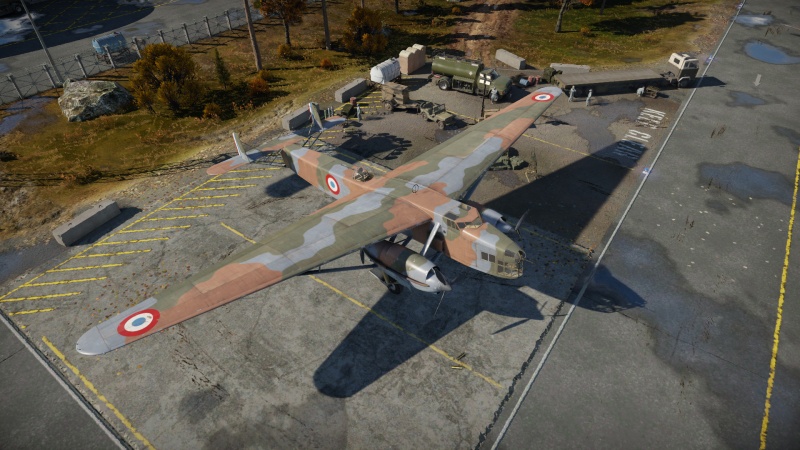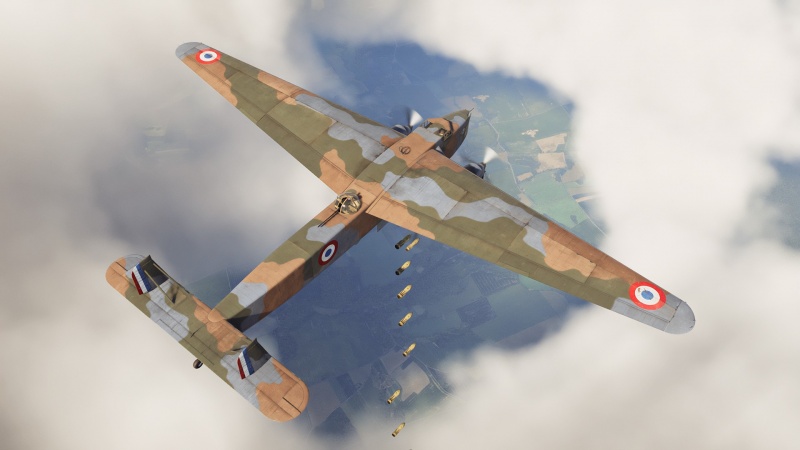N.C.223.3
Contents
Description
The N.C.223.3, as a derivative of the Farman F.220 plane model, looks strikingly similar to the F.222.2 bomber, yet different as well. The biggest difference in the design was the twin rudder on the tail that helped improve stability and yaw control. The plane's overall design was also made more aerodynamic as part of the improvement, the nose section was made shorter, and the plane introduced improved Hispano-Suiza 12Y-29 engines that replaced the previous Gnome Rhone model engines. Defensive armaments were also improved with two Hispano cannons as the rear ventral and dorsal turret armament. In 1940, with the capitulation of France, these bombers were transferred to North Africa to work as transport aircraft, to later be replaced by other cargo aircraft, such as the C-47 Skytrain.
It was introduced in Update 1.73 "Vive la France". The N.C.223.3 works like many other bombers around its BR, being slow and relying on its altitude to stay alive in battles. It has access to a big payload even when compared to other heavy bombers, with 52 x 50 kg bombs that are enough to destroy a base or even destroy the enemy airfield in coordination with allied bombers. It features a strong airframe, capable of withstanding heavy damage without being destroyed, while also having a strong defensive armament in the rear in the form of 20 mm cannons. However the defensive armament only covers a few areas of the plane, and there are multiple blind spots, especially in the tail and vertical sections.
General info
Flight performance
Despite having the appearance of a flying barn, the N.C.223.3 is a surprisingly smooth flyer. While the overall top speed is still low at only 400 km/h, in a level flight, the plane is capable of reaching a speed above 300 km/h relatively quickly and maintain its energy and climb rate quite well. Combined with its high-altitude heavy bomber spawn, this results in the plane being quite hard to catch by most planes it will have to face, even in uptiers, and allows you to travel far enough to drop your payload before the enemy reaches you.
In case some enemy pilot manages to reach your altitude, however, the N.C.223.3 still has a trick up its sleeves; manoeuvrability. Thanks to the redesigned wings and the addition of flaps, the plane has a better turn rate than the other heavy or even some medium bombers at its rank. This will allow you to face your powerful defensive armaments at the enemy and either deter them from pursuing further, or to get your guns on the target easier.
It should be remembered that, while the plane is quite agile for its size, the N.C.223.3 is still a heavy bomber. This means the usual limitations such as poor manoeuvrability at high speed, poor roll rate, and bad sustained energy retention still applies to the plane itself. Keep that in mind and you will be able to push this lumbering plane to its fullest.
| Characteristics | Max Speed (km/h at 4,000 m) |
Max altitude (metres) |
Turn time (seconds) |
Rate of climb (metres/second) |
Take-off run (metres) | |||
|---|---|---|---|---|---|---|---|---|
| AB | RB | AB | RB | AB | RB | |||
| Stock | 383 | 369 | 8000 | 29.8 | 30.4 | 4.4 | 4.4 | 520 |
| Upgraded | 417 | 400 | 28.3 | 29.0 | 9.0 | 6.4 | ||
Details
| Features | ||||
|---|---|---|---|---|
| Combat flaps | Take-off flaps | Landing flaps | Air brakes | Arrestor gear |
| ✓ | ✓ | ✓ | X | X |
| Limits | ||||||
|---|---|---|---|---|---|---|
| Wings (km/h) | Gear (km/h) | Flaps (km/h) | Max Static G | |||
| Combat | Take-off | Landing | + | - | ||
| 450 | 320 | 491 | 453 | 260 | ~5 | ~4 |
| Optimal velocities (km/h) | |||
|---|---|---|---|
| Ailerons | Rudder | Elevators | Radiator |
| < 250 | < 250 | < 300 | > 340 |
Survivability and armour
- No armour
- Self-sealing fuel tanks (4 in each wing)
The N.C.223.3 retains its durability from its predecessor. The airframe can take several hits (including some 20 mm rounds) before going down. With the wing redesign and new fuel tank placement, the plane is able to sustain fire damage a bit longer. Despite this, due to the lack of armour plating, the plane is susceptible to pilot snipes, especially from the front.
Modifications and economy
As the stock payload is highly effective, one may start at upgrading the plane's flight performance to improve the plane's manoeuvrability and speed. Then unlock the ammo belt and turret upgrade for the Hispano cannons to increase their effectiveness. The extra bombload is optional but can be considered. Due to its poor firepower, upgrades for the frontal machine gun turret can be skipped.
Armaments
Suspended armament
The N.C.223.3 can be outfitted with the following ordnance:
- 52 x 50 kg G.A. MMN. 50 bombs (2,600 kg total)
- 5 x 200 kg No.1 bombs + 7 x 100 kg No.1 bombs (1,700 kg total)
- 15 x 200 kg No.1 bombs + 7 x 100 kg No.1 bombs (3,700 kg total)
As with its predecessor, the N.C.223.3 shares a huge stock payload of 52 x 50 kg bombs. Even at a higher BR, this payload is enough to destroy all base or an airfield (including an uptier match). While the plane loses the 4 x 500 kg payload, it makes up for it with an upgraded payload of 15 x 200 kg and 7 x 100 kg bombs, although this payload is somewhat harder to manage due to its mixed nature, thus requiring the secondary weapon selection to manage the drop.
Defensive armament
The N.C.223.3 is defended by:
- 1 x 20 mm Hispano 404 cannon, dorsal turret (240 rpg)
- 1 x 20 mm Hispano 404 cannon, ventral turret (240 rpg)
- 1 x 7.5 mm MAC 1934 machine gun, nose turret (1,000 rpg)
The N.C.223.3 is equipped with two 20 mm Hispano cannons mounted in single turrets at the dorsal and ventral position, and a single 7.5 mm MAC machine gun in the nose. Accurate and hard-hitting, the Hispanos offer a much-needed defensive firepower upgrade from the F.222.2. The turrets cover most of the horizontal positions save for some blind spots around the tail, but leaves some weakspot directly above and below due to the gun's poor vertical elevation. Additionally, the low ammo count and long reload time for the Hispanos will effectively prevent any "spray and pray" usage, so aim carefully.
Meanwhile, the MAC machine guns have a rather poor performance due to the lack of firepower, and will not deter any head-on attacks on the vulnerable crew compartments. Thus, it is always recommended to always face your six at the enemy to provide more deterrence firepower.
Usage in battles
Like its predecessor, the F.222.2, the N.C.223.3 is a heavy hitting bomber with okay manoeuvrability at low altitude and low air speed, and can carry a staggering 52 x 50 kg bombs. Combined with its frequent presence in Ground Strike matches with only light vehicles, it will make short work of any (or even all) groups of armoured cars and AAA it crosses paths with. However, the ability to carry larger bomb loads later in its upgrade tree turns it into an exceptionally capable base killer, often time wiping out bases solo. 5 of the 200 kg No.1 bombs can destroy a base, so with the upgraded bombload you should be able to easily destroy 3 bases, and keep all 7 x 100 kg No.1 bombs for the enemy airfield, or to destroy the fourth base in some maps . However, it is still capable of turning entire columns of medium tanks to flaming scrap if escorted in higher level battles, with Hispano gun turrets available if an enemy tries to attack the plane.
Manual Engine Control
| MEC elements | ||||||
|---|---|---|---|---|---|---|
| Mixer | Pitch | Radiator | Supercharger | Turbocharger | ||
| Oil | Water | Type | ||||
| Not controllable | Controllable Not auto controlled |
Controllable Not auto controlled |
Controllable Not auto controlled |
Separate | Not controllable 1 gear |
Not controllable |
Pros and cons
Pros:
- Huge payload, the stock payload of 52 x 50 kg bombs are highly efficient even in uptiers
- Strong defensive firepower at the rear
- Resilient airframe capable of taking numerous damage
- Surprisingly good energy retention and manoeuvrable at medium speed, despite its size
- Can potentially win games by outright destroying the airfields with good coordination
- Spawn at a very high altitude making it almost impossible for planes to get up to it before it drops the bombs
Cons:
- Huge size with lack of armour made the plane easy to spot and were prone to pilot snipes
- Low overall top speed, manoeuvrability stiffens at high speeds
- While the plane can do some sharp turns, in doing so will bleed a considerable amount of energy, especially with vertical manoeuvres
- Poor frontal defensive firepower, highly vulnerable in head-on engagements
- Low ammunition count for the 20 mm turrets, with very long reload time
- Several blind spots around the plane's defense, especially the tail and vertical positions
History
Farman Aviation Works began working on the F.220 bomber design in 1925. This aircraft was based on a successful earlier design of the F.211 which was a parasol wing, four-engine monoplane utilizing tractor and pusher engines. While the F.211 never entered production, it served as a base for the F.220 to be designed and built from. The first successful flight of the F.220 happened on 26 May 1932.
The F.220 was a success in of itself, however, Farman made several modifications to improve the design which included a new vertical stabilizer, rebuilding the nose and ventral turret to fully enclose them and upgrading the old V-engines to new radial versions. After these modifications, the new version of the F.220 made its maiden flight in 1933.
In 1936, another variant, the F.222 first flew and this bomber incorporated retractable landing gear which reduced drag and was not available on earlier versions. A total of twenty-four aircraft of this version where produced and began service in Armee de l'Air in 1937 and was tasked with performing night bombings raids over Germany in May and June of 1940.
The F.222.2 bomber which is featured in the game had a redesigned nose and changed out the engines from Gnome-Rhône 14Kdrs engines to Gnome-Rhône 14N-11 engines.
The later F.223 which came after the F.222 saw significant changes, not only to name as it became NC.223 after Farman was absorbed into Société Nationale de Constructions Aéronautiques du Centre (SNCAC) which was the nationalization of both Farman Aviation Works and Hanriot in 1936. The aircraft's tail section was reworked and went from a single vertical stabilizer to a twin-stabilizer setup and the fuselage was refined to be more aerodynamic. Another upgrade came in the form of changes to the ventral and dorsal turret weapons. The Mle 33 7.5 mm machine guns were replaced with the more powerful H.S. 404 20 mm autocannons.
On 7 June 1940, a variant (NC 223.4) of the French Naval Aviation was the first allied bomber to fly into Germany and bomb Berlin, the flight dropped eight 250 kg and 80 x 10 kg bombs on Germany's capital. While the ordnance was not much, the psychological impact was the goal and the raid was reproduced three days later. NC 223 bombers continued to serve in bombing roles until June 1940 when they were transferred to North Africa to fulfill the role of transport aircraft.
The one in-game was a bomber version with different, weaker engines than the original NC. 223 (910 hp Hispano-Suiza 12Y-29 engines instead of the 1,100 hp engines on the NC. 223). 8 of them were built.
Media
- Skins
- Videos
See also
Links to the articles on the War Thunder Wiki that you think will be useful for the reader, for example:
- reference to the series of the aircraft;
- links to approximate analogues of other nations and research trees.
External links
- [Devblog] NC.223.3: let nobody leave unsatisfied!
- Official data sheet - more details about the performance
- [Wikipedia] Farman F.220
| Farman Aviation Works (Avions Farman) | |
|---|---|
| Bombers | F.222.2 · N.C.223.3* |
| * Originally the F.223, it was redesignated NC.223 when Farman Aviation was absorbed into the nationalized SNCAC | |
| France bombers | |
|---|---|
| Farman | F.222.2 · N.C.223.3 |
| Latécoère | Late 298D |
| Potez | Potez 633 |
| Liore et Olivier | LeO 451 early · LeO 451 late |
| Bloch | M.B.174A-3 · M.B.162 · M.B.175T |
| American | V-156-F · Martin 167-A3 · ▄A-35B · ▄SB2C-5 · B-26C · ▄PBY-5A Late · ▄PB4Y-2 |
| British | Lancaster MR.7 |






